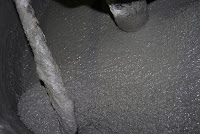
I would like to try to clarify the jungle of
short names of high strength concrete
names in the literature. The reason for
this is, that I have once again read a technical
master thesis from the field of civil
construction of a European university and
where only with short descriptions is
thrown around.
The first high-strength cement binder with a
compressive strength of well over 100 MPa
was developed in Denmark more than 30 years
ago. The aim of the development was to
produce a high-strength cement binder, which
was also very successful. At that time, the
focus was on the binder and not on possible
aggregates or reinforcement systems. For this
reason, an extremely high-strength binder was
always used in all the discussions.
Much later, to the dismay of many, the term
UHPC appeared in the literature. In our opinion,
this term UHPC cannot be clearly defined. It
also seems to be a fad to further water down this
term and everyone who thinks he has understood
ultra high-strength concrete creates his own short
form.
I would like to list the short forms here and provide
appropriate comments.
The UHPC binder is made of a special grade of
cement, microsilica and superplasticizer.
UHPC Ultra High Performance Concrete
Consists of UHPC binder + aggregates, which
can have different material grades and grain sizes
There are no standards which additives and surcharges of
which material quality and grain size must be used.
HPC High Performance Concrete
Consists of cement + aggregates + additives
There are no standards which additives and surcharges of
which material quality and grain size must be used. Likewise,
there are no standards about the technical properties.
RHPC Reinforced High Performance Concrete
Consists of cement + aggregates + additives and
unspecified reinforcement
There are no standards which additives and surcharges of
which material quality and grain size must be used. Likewise,
there are
no standards about the technical properties. There
is no specification for material quality, dimensions and
quantities for the reinforcement

HRUHPC Heavy Reinforced Ultra High Performance Concrete
Consists of UHPC binder + aggregates, which
can have different material qualities and grain
sizes, and an unspecified reinforcement
There are no standards which additives and surcharges
of
which material quality and grain size must be used.
Likewise, there are
no standards about the technical
properties. There is no specification
for material quality,
dimensions and quantities for the reinforcement
SFRC Steel Fiber Reinforced Concrete
Consists of cement + aggregates + additives +
steel fibers
There are no standards which additives and surcharges of
which material quality and grain size must be used. Likewise,
 there are
no standards about the technical properties. For the
fibers there is no specification of material quality, dimensions
and quantities.
there are
no standards about the technical properties. For the
fibers there is no specification of material quality, dimensions
and quantities.
RPC Reactive Power Concrete
Consists of cement + sand + quarz powder,
silica fume, steel fiber and superplasticizer
There is no standards of the quality of cement, sand
silica fume must be used.
Anyone, university, technical literature or expert, will
take part in this Babylonian jumble without bothering
to really specify UHPC. At the moment many talk
about many things, but only a few about the same.
In my opinion, there should be only one UHPC binder
quality with one name and what is admixed to like
aggregates, fiber, reinforcements and much more is up
to the user. The UHPC binder manufacturer should only
manufacture according to the UHPC binder specification.
If one agreed internationally on a technical specification,
there would be very few UHPC producers from that day
on and many would have to name their products
differently or dramatically improve their material quality.
www.hhbc-consulting.de
info@hhbc-consulting.de

















































